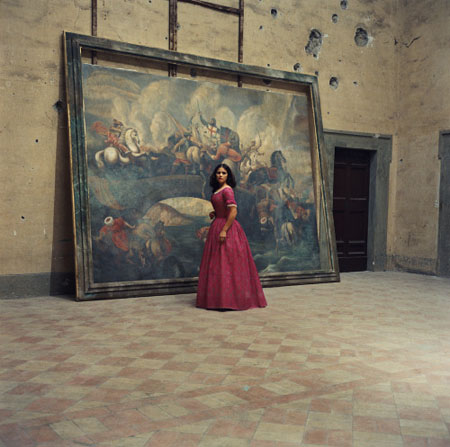Olivier Assayas has managed to squeeze 22 films onto his list of top ten Criterion releases. His #1: Luchino Visconti‘s The Leopard (1963). “One of the greatest films ever made by a director who, almost forty years after his death, is still an intimidating and disturbing figure in the history of cinema,” he writes. “Visconti’s films stand outside the borders of the medium, by their ambition, by their scope, uniting past and present, individuals and history, both deeply human and transcendent. The Leopard, his most translucent, towering achievement, embodies everything the best filmmaking can be, grand, profound, entertaining, physical and metaphysical, sharp as a blade and melodramatic. It stays with you, forever.”
Reviewing Criterion’s recent release of Eclipse Series 42: Silent Ozu—Three Crime Dramas, Peter Labuza notes the ways “each film recalls the American melodrama. That Night’s Wife essentially becomes a family chamber drama of its three characters in a bedroom, while Walk Cheerfully and Dragnet Girl are opposites-attract love stories. Ozu’s articulation of melodramatic attitudes can be much more jarring in comparison to his canonical work—if anything, these silent films are much louder.”
Also at the Film Stage, is Peter‘s piece on two more Criterion releases, Le silence de la mer (1949) and The River (1951). “On one side, the young blood of Jean-Pierre Melville, a so-called American in Paris—but, more accurately, a geometrician of human calculations. On the other: the old master, Jean Renoir, who makes every moment of cinema feel accidentally captured, and thus indelibly human.”
“Costa-Gavras might be the European filmmaker most influential on American directors of the 1970s,” writes Clayton Dillard. “Although this honor often goes to Jean-Luc Godard and other compatriots of the Nouvelle Vague, films like The French Connection, The Parallax View, or Blow Out are most clearly engaged with a clamorous mode of political cinema that’s as fundamentally enraged as it is delicately assembled.” And on another page at Slant, Dillard writes, “If Z [1969] effectively created the template for the contemporary political thriller and The Confession [1970] dialed down the pulsating inclinations for a hard-edged examination of ideological injustice, the final entry”—State of Siege (1972)—”synthesizes the two approaches, creating a work that’s thrilling for its interest in process, procedure, and collective responsibility over the ill deeds of a few. More than in either previous film, Costa-Gavras indicts both sides of the terrain for their abuse of power and action.”
Costa-Gavras in Cannes on the new restoration of Z (1969)
See, too, Mark Danner. Also writing for Criterion are Thomas Elsaesser on The Merchant of Four Seasons (1971), “a turning point in Rainer Werner Fassbinder’s career,” and the late Peter von Bagh on Charlie Chaplin‘s last American film: “London is for the one and only time the center of his story, an emotional sum of elements that abound in his oeuvre… But the reflexive nature of Limelight (1952) makes it equally a film about America.”
Across the Atlantic, the BFI has released Helma Sanders-Brahms’s original cut of Germany Pale Mother (1980) on Blu-ray. For Erica Carter, the film, revived only last year, confirms its maker “as a brilliant cineaste with a keen eye for the gender dimensions of German historical memory…. Germany Pale Mother bears numerous traces of the film’s rooting in second-wave cine-feminism. The film’s stylistic tendency to Brechtian estrangement reveals its debt to debates on counter-cinema that exercised both Sanders-Brahms’s feminist contemporaries, and the filmmaker herself in her own later critical writings.”
And Charlie Chaplin: The Mutual Comedies 1916-1917 showcases “the sublime offerings of the Chaplin who was able to move from rawness to sophistication without discarding the vulgarities and flounces that made the Little Tramp simultaneously a common identity figure and a would-be exquisite,” writes Geoff Andrew.
Reviewing Blaq Out’s release of twelve films Koji Wakamatsu made between 1965 and 1972 in three box sets (Volumes 1, 2 and 3) for One+One, Benjamin Noys argues that “it is not possible to divide Wakamatsu the ‘soft-core auteur’ from Wakamatsu the political filmmaker.”
At RogerEbert.com, Glenn Kenny writes about “The Politics of Murdered (and Murderous) Women”—in two parts. “Watching Blood and Black Lace [1964] in a gorgeous, eye-popping restoration now on Blu-ray disc courtesy of the Arrow label, the visual quality of the film often overwhelms all other considerations,” writes in Part 1. Mario Bava “was a master of in-camera illusions, dazzling lighting effects, and color, and he orchestrates his sequences of death like a stage magician walking through an especially elaborate trick…. For all that, Bava’s poetic morbidity attempts to do an end run around the idea of misogyny, rather than face up to it…. [T]he film’s murder scenes act as Rorschach tests for the viewer, albeit one especially crafted for the male gaze: how close together do you like your Eros and Thanatos?”
In Part 2, he takes on Walerian Borowczyk‘s The Strange Case of Dr. Jekyll and Miss Osbourne (1981), noting that “in a movie watching time when any cinematic object offering a bromide of ’empowerment’ is praised as ‘subversive,’ it’s refreshing to see a movie that genuinely yearns for the overturning of the social order, no matter how impractical. Borowczyk’s vision of sexual freedom as a potentially irresistible force makes for a powerfully disturbing and admirably direct 90-minute cinema experience.”
Peter Cowie talks with Costa-Gavras
For news and tips throughout the day every day, follow @KeyframeDaily. Get Keyframe Daily in your inbox by signing in at fandor.com/daily.




